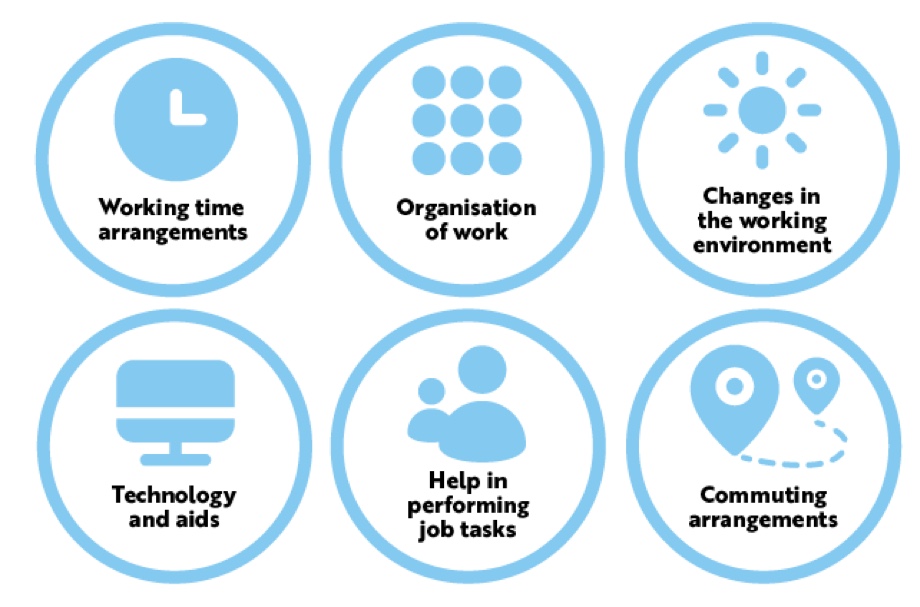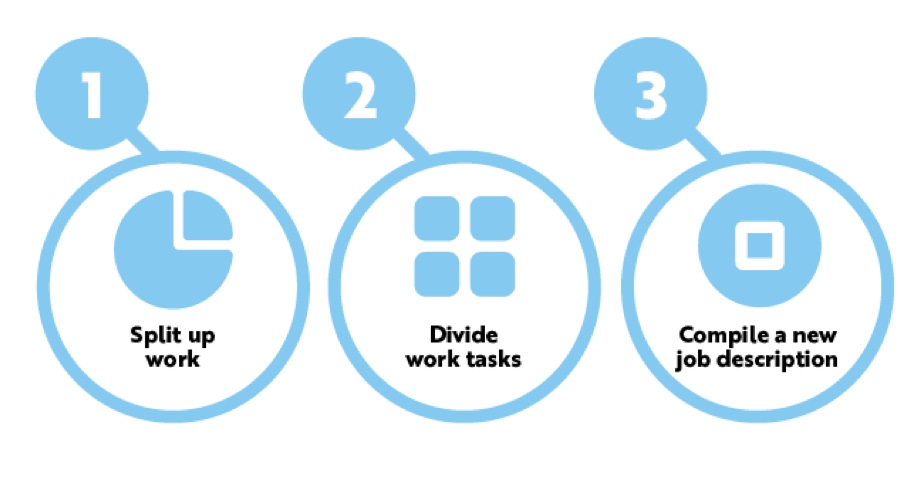Putting work input to use by modifying work tasks
Modifying work tasks and building new job descriptions will make it possible for companies to successfully hire jobseekers with partial work ability, and companies get new labour for their genuine needs. The modification of work tasks is also a viable solution in situations where an employee in the workplace experiences temporary or permanent reduced work capacity.
Work tasks suitable for persons with partial work ability can be built in the workplace from existing job descriptions. The aim is to create suitable, modified work for a person with partial work ability by reforming the division of labour.
Means and methods for the modification of work

- Working time arrangements, such as part-time work
- Reorganisation of work, including the specification of work tasks
- Changes to the working environment, such as improving the accessibility of workspaces.
- Technology solutions and aids, such as computer programs and aids
- Getting help at work, such as assistance provided by a work community or colleague
- Solutions for commuting, such as transport services
- Job description form, a model developed in the Easy Steps toward Working Life project
- Ratko model for the modification of work
Employees with partial work ability can get the aids they need at work free of charge through Kela, health care providers or an earnings-related pension company. Un the Act on Disability Services and Assistance, the employee has the opportunity to receive support from his or her own municipality for commuting to and from work.
The modification of work tasks may also include the use of Kela’s interpreter services, in which case an employee with a hearing or speech impairment may receive sign language interpretation for their work. This will not result in costs for the employer. For more information on the subsidies available to employers, see the section Financial support for employers.
Modify work tasks for genuine need
The aim is to ensure that the various stages of work task modification, hiring and employment are managed systematically and professionally. Before you start modifying new work tasks, consider how you want to benefit from this and how the company will benefit from it. Consider what kind of competence your company needs now and in the future. What kind of tasks have not been assigned to anyone and what tasks could be reorganised? Consider whether the new modified position can be duplicated and utilised elsewhere in the company.
Use a job description form
When modifying a position or building a new job description, you can use the job description form developed in the Easy Steps toward Working Life project. The job description form describes the position and its requirements.
The information in the form can be used to prepare a job advertisement or can be provided to employment services when looking for a jobseeker with partial work ability. The form will make it easier to use employment services and to find a suitable jobseeker with partial work ability.
Job description form, a model developed in the Easy Steps toward Working Life project (pdf)
Building new work tasks
In the Ratko method, work is examined and modified in three stages. Ratko method is developed by Vamlas, the Support Foundation for Disabled Children and Young People.

1. Splitting work
2. Division of works tasks into tasks requiring core competence and other tasks
Once tasks have been described in visual form, they are easier to split into parts.
- Which tasks require the professional skills, training and experience of existing staff?
- What could an employee with different competence and work ability do?
- Are there unfinished work tasks in the workplace that desperately need to get done?
3. Compiling a new job description
After the division, employees decide which tasks could be handed over to someone else. These separated pieces will be put together to form a new position, which will improve the efficiency the work community as a whole or, if necessary, several new positions.
Utilisation of the new, ready job description
A new employee, a work try-out participant or even an intern from an educational institution can be recruited to the completed job description. The position can be modified individually so that it is ideal for the newly chosen worker. The new job description can also be utilised in work ability solutions, such as returning to work from sick leave or challenges related to coping at work. If the organisation has more than one office, the job description can be duplicated for the use of all offices.
Utilise and study the Ratko method
Work tasks can be modified and built together by persons responsible for recruitment or together with the employees. Vamlas, the Support Foundation for Disabled Children and Young People has developed the Ratko method, which offers means for the analysis, organisation and shaping of work.
The Ratko method allows employees to look through their basic tasks together and identify potential overlapping and tasks that are not part of their basic job description. Based on these findings, they will decide whether there is reason to reform the division of labour:
- Could some tasks be eliminated completely?
- Could these eliminated work tasks be compiled into a new position for another person.
This will allow everyone’s work input to be utilised in just the position and tasks for which it is needed and best suited.





